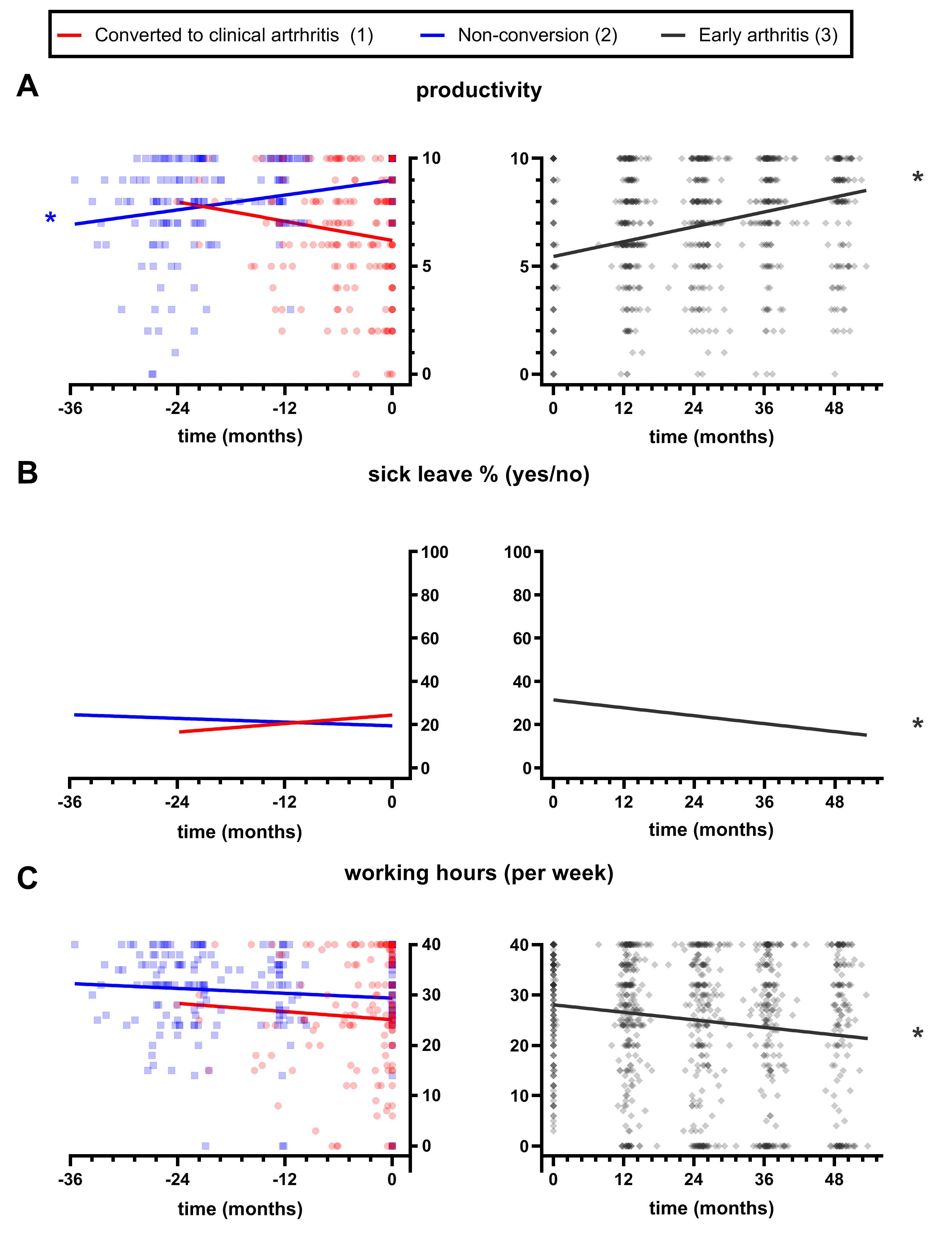Session Information
Date: Saturday, November 6, 2021
Title: Patient Outcomes, Preferences, & Attitudes Poster I: Impact (0225–0240)
Session Type: Poster Session A
Session Time: 8:30AM-10:30AM
Background/Purpose: Work participation is still a major issue for patients with rheumatoid arthritis (RA) despite improved management and outcomes. Work loss can be divided into presenteeism (i.e. impaired productivity while at work) and absenteeism (i.e. absence due to illness). Both constitute limitations for the patient as well as an economic burden for society. It is known that in the phase preceding clinical arthritis patients already experience pain and functional limitations. We therefore aimed to investigate how work participation is affected in patients with arthralgia in the ‘pre-RA phase’ during transition to RA or symptom resolution, and to compare this to the course of the work participation in early RA-patients.
Methods: Three groups of patients were studied; 143 arthralgia-patients converting to clinical arthritis within two years (the Leiden CSA cohort, the SONAR cohort), 617 early RA-patients during 4 years of follow-up (the Leiden EAC) and 57 arthralgia-patients not converting to clinical arthritis with spontaneous resolution of symptoms (Leiden CSA cohort). WPAI and IPCQ were used to measure work-related outcomes. Both presenteeism (impaired productivity at work; scale 0-10 where 0=complete impairment and 10=no impairment) and absenteeism (sick leave and decrease in working hours) were taken into account. Linear Mixed Models and Mixed effect logistic regression models were used to investigate whether the work-related outcomes changed over time. Outcomes were also stratified for ACPA status.
Results: A total of n=103 (72%), n=291 (47%) and n=50 (88%) had paid work at baseline (i.e. the working population). One year prior to the development of clinical arthritis, productivity decreased with 36% (95% CI 24% to 48%), following a downward trend towards the level of RA-patients at diagnosis which was decreased with 50% (95% CI 47% to 53%). Sick leave was reported by 28% ( 95% CI 20% to 36%) one year prior to the development of clinical arthritis and followed an upward trend towards the level of RA-patients at diagnosis (36% 95% CI 30% to 41%) (Figure1). After treatment start in RA, productivity improved (p< 0.0001), and sick leave decreased significantly (p< 0.0001. Despite an improvement in productivity and sick leave, working hours significantly decreased over time after being diagnosed with RA(p< 0.0001). Within the arthralgia-patients with spontaneous symptom relief (n=50), a significant improvement in productivity was observed over time(p=0.0016). Stratifying for ACPA showed no difference in work-related outcomes.
Conclusion: Before clinical arthritis is apparent, the productivity level of arthralgia-patients is decreased towards a similarly reduced productivity level in early RA-patients. This underlines the importance of recognizing patients in the pre-arthritis phase, as intervention in this phase could potentially prevent loss in work participation.
Legend: (1) arthralgia-patients converting to clinical arthritis; 0 at x-axis marks the moment arthritis is diagnosed (2) non-converting arthralgia-patients with spontaneous symptom relief; 0 at x-axis marks the moment patients were symptom free (3) RA-patients; 0 at x-axis marks the moment of diagnosis. Productivity where 0=minimal workplace productivity, 10=maximal workplace productivity.
*marks a significant change over time.
To cite this abstract in AMA style:
Rogier C, de Jong P, van der Helm-van Mil A, van Mulligen E. Work Participation Is Impaired Months Before Clinical Arthritis Is Apparent [abstract]. Arthritis Rheumatol. 2021; 73 (suppl 9). https://acrabstracts.org/abstract/work-participation-is-impaired-months-before-clinical-arthritis-is-apparent/. Accessed .« Back to ACR Convergence 2021
ACR Meeting Abstracts - https://acrabstracts.org/abstract/work-participation-is-impaired-months-before-clinical-arthritis-is-apparent/

